Themed collection Molecular Analysis for Art, Archaeometry and Conservation

Molecular Analysis for Art, Archaeometry and Conservation
This Editorial introduces the web collection on Molecular Analysis for Art, Archaeometry and Conservation, guest edited by Francesca Casadio and Richard Van Duyne.

Analyst, 2013,138, 7276-7278
https://doi.org/10.1039/C3AN90096G
Near infrared (NIR) spectroscopy : a potential new means of assessing multi-phase earth-built heritage
The analysis of clays within historic earth buildings is commonly achieved through X-ray diffraction, which is reliant upon extraction. Portable near infrared spectroscopy allows in situ differentiation between clays.
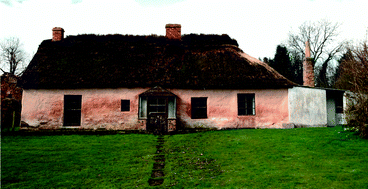
Anal. Methods, 2013,5, 4574-4579
https://doi.org/10.1039/C3AY40735G
Analysis of cadmium-based pigments with time-resolved photoluminescence
For the first time we report the band edge and trap state luminescence decay kinetics of cadmium pigments. The measured lifetimes suggest that carrier recombination is highly influenced by non-radiative decay paths such as electron trapping. Our findings highlight how luminescence measurements are useful in the conservation science field.
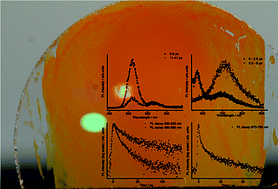
Anal. Methods, 2014,6, 130-138
https://doi.org/10.1039/C3AY41585F
Looking beneath Dalí's paint: non-destructive canvas analysis
A new analytical method was developed to non-destructively determine pH and degree of polymerisation (DP) of cellulose in fibres in 19th–20th century painting canvases, and to identify the fibre type: cotton, linen, hemp, ramie or jute.
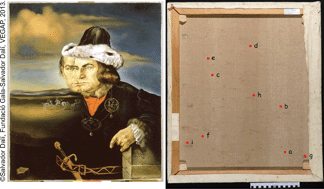
Anal. Methods, 2014,6, 86-96
https://doi.org/10.1039/C3AY41094C
Is Khirbet Kerak Ware from Khirbet al-Batrawy (Jordan) local or imported pottery?
A multi-analytical approach has been applied to characterize Khirbet Kerak Ware, a distinctive pottery production of Early Bronze III Levant.
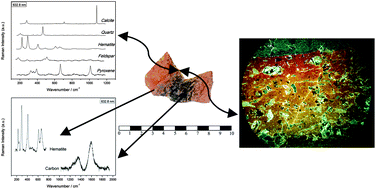
Anal. Methods, 2013,5, 6622-6630
https://doi.org/10.1039/C3AY41304G
Non-destructive characterization of archaeological resins: seeking alteration criteria through vibrational signatures
New insights into copal degradation mechanisms are introduced and relevant analytical strategies for resinous substances through non-destructive approaches by FT-Raman and ATR-IR are presented.
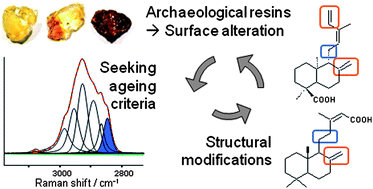
Anal. Methods, 2013,5, 6583-6591
https://doi.org/10.1039/C3AY41278D
SR-FTIR imaging of the altered cadmium sulfide yellow paints in Henri Matisse's Le Bonheur de vivre (1905–6) – examination of visually distinct degradation regions
Cadmium yellow photo-degradation products are imaged in thin sections from Matisse's Le Bonheur de vivre allowing for degradation mechanism elucidation.

Analyst, 2013,138, 6032-6043
https://doi.org/10.1039/C3AN00892D
Silver colloidal pastes for dye analysis of reference and historical textile fibers using direct, extractionless, non-hydrolysis surface-enhanced Raman spectroscopy
Silver colloidal pastes, characterized by SEM, allowed the first extractionless SERS identification of two dyes simultaneously on historical Fortuny textiles.

Analyst, 2013,138, 5895-5903
https://doi.org/10.1039/C3AN00788J
Alteration of Asian lacquer: in-depth insight using a physico-chemical multiscale approach
A new approach was developed as a probe for alteration of Asian lacquer using SEM, microtopography and SR micro-FTIR.

Analyst, 2013,138, 5685-5696
https://doi.org/10.1039/C3AN00608E
Quantifying degradation of collagen in ancient manuscripts: the case of the Dead Sea Temple Scroll
A quantitative method based on polarized Raman spectroscopy was developed to assess the degree of collagen degradation in historical parchments.

Analyst, 2013,138, 5594-5599
https://doi.org/10.1039/C3AN00609C
Characterization of the Dead Sea Scrolls by advanced analytical techniques
Fast 2D-XRF scanning helps to differentiate between the minerals from the production process and the sediments from the archaeological site.

Anal. Methods, 2013,5, 4648-4654
https://doi.org/10.1039/C3AY41076E
Vibrational spectroscopy correlated with elemental analysis for the investigation of smalt pigment and its alteration in paintings
New insights into the chemical structure of smalt pigment, before and after degradation, from the application of synchrotron micro-infrared spectroscopy and micro-Raman directly on smalt particles within paint cross-sections.
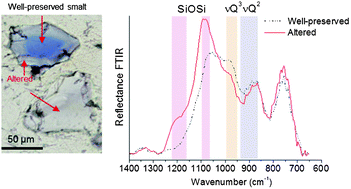
Anal. Methods, 2013,5, 4628-4638
https://doi.org/10.1039/C3AY40906F
Proteomics applied to the authentication of fish glue: application to a 17th century artwork sample
This work provides the first identification of fish glue from a few micrograms of a 17th century polychromy sample using an adapted proteomics approach.
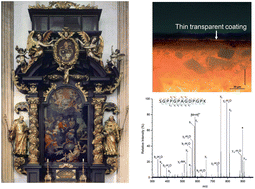
Analyst, 2013,138, 5357-5364
https://doi.org/10.1039/C3AN00786C
Mobile Raman spectroscopy analysis of ancient enamelled glass masterpieces
Richly decorated enamelled glass objects and fragments of different provenance and epoch (1st c.–14th c.) have been analysed using mobile and fixed Raman instruments. The comparison with data existing in literature, allowed to discuss the technology of this class of precious artefacts and the potential of the mobile Raman analysis.
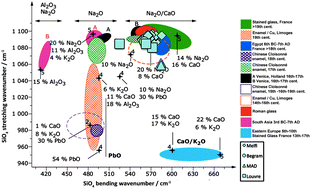
Anal. Methods, 2013,5, 4345-4354
https://doi.org/10.1039/C3AY40648B
Mapping of egg yolk and animal skin glue paint binders in Early Renaissance paintings using near infrared reflectance imaging spectroscopy
Development of high sensitivity standoff chemical imaging to map artist's selective use of binding media across entire painting.

Analyst, 2013,138, 4838-4848
https://doi.org/10.1039/C3AN00926B
Systematic study of terahertz time-domain spectra of historically informed black inks
Advanced iron gall ink corrosion (image courtesy Nationaal Archief) and a terahertz spectrum of model iron gall ink.
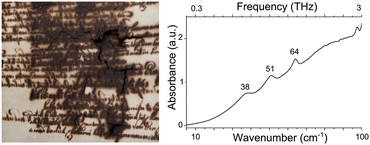
Analyst, 2013,138, 4859-4869
https://doi.org/10.1039/C3AN00331K
Identification of collagen-based materials in cultural heritage
Peptide mass fingerprinting provides species level identification of soft tissue materials from cultural heritage.
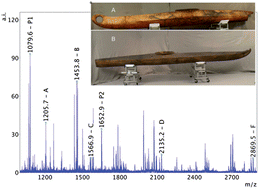
Analyst, 2013,138, 4849-4858
https://doi.org/10.1039/C3AN00925D
Statistical methods and library search approaches for fast and reliable identification of dyes using surface-enhanced Raman spectroscopy (SERS)
SERS combined with simple statistical techniques and library search methods enables fast and reliable identification of dyes from different samples.
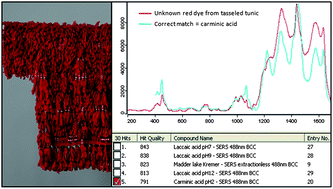
Anal. Methods, 2013,5, 4205-4212
https://doi.org/10.1039/C3AY40673C
Multivariate analysis of pyrolysis-GC /MS data for identification of polysaccharide binding media
The method of Thermally assisted Hydrolysis and Methylation (THM) was applied to the analysis of plant gums that can be found in artistic and archaeological objects.
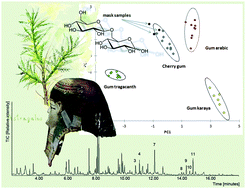
Anal. Methods, 2013,5, 4060-4067
https://doi.org/10.1039/C3AY40474A
‘It's not easy being green’: a spectroscopic study of green pigments used in illuminated manuscripts
Combining reflectance spectroscopy with an historic literature survey yields a contextualized study of green pigments used in medieval French illuminations.
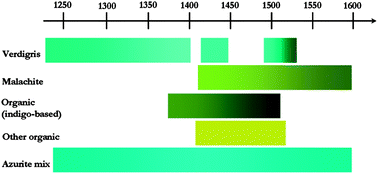
Anal. Methods, 2013,5, 3819-3824
https://doi.org/10.1039/C3AY40530C
Characterization of blood in an encrustation on an African mask: spectroscopic and direct analysis in real time mass spectrometric identification of haem
DART-TOF-MS with in situ derivatisation provides rapid confirmation of the presence of blood in a museum object.
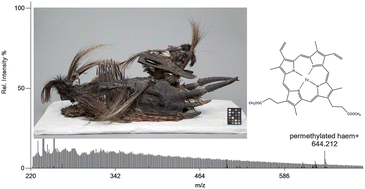
Analyst, 2013,138, 4470-4474
https://doi.org/10.1039/C3AN00633F
Electrochemical SERS study on a copper electrode of the insoluble organic pigment quinacridone quinone using ionic liquids (BMIMCl and TBAN) as dispersing agents
Electrochemical SERS experiments of the insoluble pigment quinacridone quinone dispersed in ionic liquids (BMIMCl and TBAN) are reported.
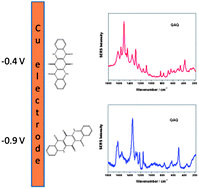
Analyst, 2013,138, 4670-4676
https://doi.org/10.1039/C3AN00446E
Surface-enhanced Raman spectroscopy studies of yellow organic dyestuffs and lake pigments in oil paint
Development of a SERS-based approach for the detection of various yellow dyestuffs, lake pigments, and oil paints.
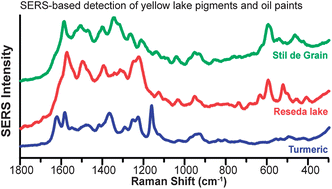
Analyst, 2013,138, 4493-4499
https://doi.org/10.1039/C3AN00611E
Alternative SERRS probes for the immunochemical localization of ovalbumin in paintings: an advanced mapping detection approach
The immuno-SERRS procedure combines the selective localization of ovalbumin with the simultaneous Raman mapping of different paint components.
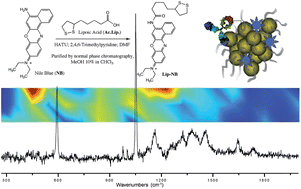
Analyst, 2013,138, 4532-4541
https://doi.org/10.1039/C3AN00057E
A multiscalar photoluminescence approach to discriminate among semiconducting historical zinc white pigments
In order to fully characterize the zinc white artists' semiconductor pigment (ZnO), much used since the mid-nineteenth century, three historical samples were studied using a combination of synchrotron and macroscopic photoluminescence spectroscopy and imaging to allow their differentiation.

Analyst, 2013,138, 4463-4469
https://doi.org/10.1039/C3AN36874B
About this collection
This collection of papers across Analyst and Analytical Methods highlights cutting edge analytical research from academia, national laboratories and museums showing the most recent analytical breakthroughs in the field of cultural heritage. The articles describe those techniques recently employed to study art and cultural objects at the molecular level, characterising their structure, properties and chemistry. The themed issue is Guest Edited by Francesca Casadio and Richard P. Van Duyne. New articles will be added to this collection as they are published.